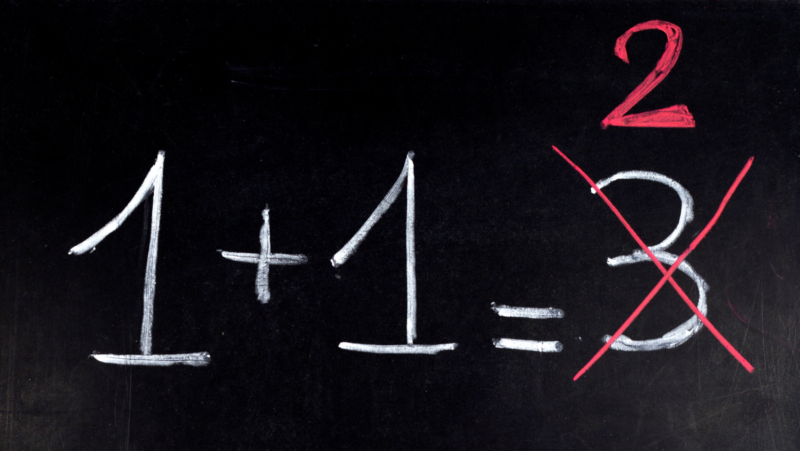Insights
Learn From Mistakes: Fostering Visible Math Thinkers
The mission of ORIGO Education is to make mathematics meaningful, enjoyable, and accessible. In order to do that, one has to understand it. Teachers and students are often quick to focus on whether an answer is simply correct or incorrect. The student either got it or they didn’t. Just grade the assignment and move on is unfortunately a common practice for some educators. That isn’t teaching a student to learn from their mistakes, though. There is much more to math mistakes than just marks on a page. What does that incorrect answer indicate? Did the student make a careless error, or do they not understand the concept or skill required for that type of math problem?
Both teachers and students have to change their mindsets about how mistakes are viewed. It is important to get away from the idea that completing every answer correctly very fast is the definition of being good at math. Sara Delano Moore (ORIGO’s Vice President of Research & Content) says as a teacher, it is important to remind yourself and your students “that learning is a process that takes time.” “Mistakes are indications our brain is working, that it’s growing, [and] that it’s learning.”

Shifting Mindsets: How Students Can Learn From Math Mistakes
The following are several tips to help shift students’ mindsets to view mistakes as learning opportunities:
- Normalize mistakes: Remind students that making mistakes is a normal part of the learning process and that everyone makes mistakes. Ask them what the eraser on their pencil is for. It’s for erasing mistakes. What happens once a mistake is erased? You try again. Mistakes are proof that someone is trying. Model this mindset as you teach by humbly admitting when you make a mistake and being willing to correct that mistake. When solving a word problem, did you write the wrong number in the equation or forget to borrow in a subtraction problem? You can model how to handle correcting a mistake by simply saying, “Oops, I made a mistake there. Let me fix it.” No tears, no shame, no excuses. You just owned your mistake and showed a willingness to try again. If a student points out your mistake, you can respond with, “Oh, thanks for pointing that out to me. I’ll try again.”

- Emphasize a growth mindset: Encourage students to reflect on their mistakes and think about what they can learn from them. Prompt them to ask questions of themselves like, “What went wrong? How can I do better next time?” Encourage students to adopt a growth mindset, where they see mistakes as opportunities for growth and improvement rather than as failures. Display growth mindset posters and quotes around the room. Use growth mindset language. For example, “I don’t understand this yet.” For more information on how growth mindset language can transform your math class, check out this article.
- Provide constructive feedback: When giving feedback on mistakes, focus on what the student did well and what they can improve on, rather than just pointing out the mistake. Here are some examples of constructive feedback:
- “I see that you worked really hard on this problem. There is a mistake in your calculations, though. Let’s walk through it together and see if we can find where the error happened and how to fix it.”
- “You have a good grasp of the concept overall. Make sure to show your work step by step so you can see where you might have made a mistake.”
- “You’re on the right track with this problem. Don’t forget to check your answers to make sure they make sense in the context of the problem.”
- “I like how you explained your thinking in this problem. Remember to use specific math vocabulary in your reasoning so others can follow your thought process too.”
- “Great job on solving this equation! Next time, double check your work to catch any mistakes before moving on to the next problem.”

- Encourage perseverance: Help students develop a sense of resilience and perseverance by reminding them that mistakes are a natural part of learning and that it’s important to keep trying and not give up. Give examples apart from math that require perseverance. For example, does that student play basketball? Did they know how to shoot well the first time they tried? Probably not. They continue practicing to get better at making more shots, from different angles, when an opponent is trying to block them, etc. The important thing is that they don’t give up just because they missed one shot. Explain how math is the same way. Just because you get one problem wrong doesn’t mean you give up. You try again. You ask for help understanding as needed. You learn how to get it right in the future.
- Cultivate a supportive math community: Create a positive classroom culture where mistakes are recognized as opportunities for learning and growth rather than something for which to be criticized or punished. It is also important to communicate with parents or guardians about how mistakes are viewed as learning opportunities within your classroom. Sadly, many students feel pressure from home to get excellent grades. They can become fearful of how their mistakes will be judged. Therefore, it is important to encourage parents or guardians to foster the same supportive atmosphere for students at home as you are trying to cultivate within your classroom.
- Set realistic expectations: Help students understand that making mistakes is a common part of the learning process and that they shouldn’t expect to get everything right on the first try. Dr. Moore adds that students should come to realize, “If I am getting every question right, my teacher is not pushing me hard enough.” This requires a mindset shift for students to desire to grow in their knowledge of mathematical skills and concepts and be willing to be pushed to their fullest potential. Check out this resource for ideas to help your students set goals in math!
- Encourage problem-solving: Encourage students to use their mistakes as a starting point for problem-solving and critical thinking. Help them recognize why the mistake happened and how they can avoid making the same mistake in the future.

For years, students have been asked to “show your work.” A more recent requirement within math standards is for students to “show your thinking.” This bridges the knowledge of how (mathematical skills) with understanding why (mathematical concepts). It is a key element in cultivating a classroom of visible math thinkers. We cannot read a student’s mind (and are probably very glad of that at times), but with visible thinking strategies, we can understand what they are thinking through the information they share in a variety of ways. Students are also able to understand what we are thinking and what their peers are thinking when solving mathematical problems. For a more detailed explanation of visible thinking and the research behind it, read What Is Visible Thinking?
Cultivating Visible Thinking: Strategies for Learning From Mistakes
- Display and discuss learning targets: Help students understand what they will be learning each day and within each chapter or module and how their knowledge will be assessed. This helps them know what the big idea is, how the class is going to get there, and what evidence is required to show the student understands the concept.
- Use “I can” statements. For example, “I can subtract two-digit numbers with and without borrowing.”
- Let them know what the assessment will be for each day, week, chapter, module, etc. (i.e., how they will be able to demonstrate they can). Assessment should include a much higher percentage of formative assessments than summative assessments. Students need to be provided with ongoing feedback and support throughout their learning process. Click here for tips on effectively responding to assessment data.

- Incorporate number talks into lessons: Have students explain their thinking as they solve math problems, focusing on strategies, patterns, and relationships between numbers.Check out these resources for more information about number talks:
4 Number Talks & Examples to Try Today – Simply Creative Teaching
The Ultimate Guide to Number Talks – Hello Learning - Encourage math reflection: Have students reflect on their math learning experiences, identifying what strategies were most effective for them and areas for improvement.
- Use math journals for students to write about their thought processes as they work through math problems, highlighting their reasoning and problem-solving strategies. By writing in math journals, students can spot their mistakes easier and learn from them.
- Exit tickets are a simple way to assess if a student can identify what they were intended to learn in that lesson, why they were meant to learn it, and to demonstrate if they actually learned it.
- Incorporate error analysis activities: These types of activities are a way for students to practice identifying and correcting mistakes. Activities could include:
- math problems that multiple students missed on an assessment
- having students correct a peer’s classwork: If you prefer students to not know whose work they are correcting, assign each student a number to write on their paper instead of their name. Make sure only you and the student know that number. For example, don’t assign numbers according to an alphabetical student roster.
- pre-made problems that consist of various mistakes to practice specific skills
- three-round error analysis group activity: Students are divided into three groups. In the first round, each group creates or is given a problem related to the current unit of study in which a common mistake might occur (i.e., forgetting to borrow in a subtraction problem or not carrying in a multiplication problem). They intentionally solve it incorrectly without indicating where the error is. In the second round, groups rotate and identify the error in the solution provided by the previous group. They correct the mistake in a different color and solve the problem accurately. In the third round, groups rotate again and analyze the problem, the incorrect solution, and the correct solution from previous groups. They explain the mistake made by the first group and the correct solution provided by the second group to the class in written form, and then read the explanation to the class.
- math problems that multiple students missed on an assessment

- Foster critical thinking skills and effective communication: Critical thinking skills empower students to learn from their mistakes by uncovering the root cause of the error and developing effective strategies to avoid similar mistakes in the future. Click here for more tips on promoting critical thinking skills.
- Present students with open-ended math problems that require critical thinking and multiple strategies to solve. Trying different ways to solve tricky math problems helps students identify and learn from their mistakes.
- Engage students in healthy debates or discussions about different approaches to solving math problems, encouraging them to defend their reasoning and consider alternative perspectives.
- Promote effective communication skills through the use of math vocabulary, as described in this article.
- Provide students with challenging math puzzles that require them to think critically and creatively to find solutions.
- Engage students in hands-on math investigations that allow them to explore mathematical concepts and relationships through inquiry-based learning.
All of these strategies, and many more, are ways to cultivate a classroom of visible math thinkers who recognize that mistakes are not failures but are opportunities to learn and grow.



